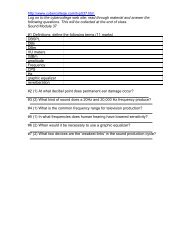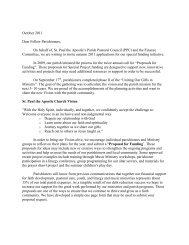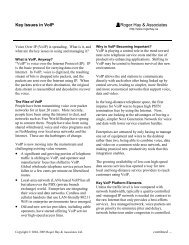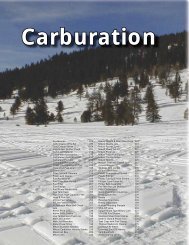MHR Calculus and Vectors 12 Solutions 462 Chapter 4 Review ...
MHR Calculus and Vectors 12 Solutions 462 Chapter 4 Review ...
MHR Calculus and Vectors 12 Solutions 462 Chapter 4 Review ...
You also want an ePaper? Increase the reach of your titles
YUMPU automatically turns print PDFs into web optimized ePapers that Google loves.
<strong>Chapter</strong> 4 <strong>Review</strong><br />
<strong>Chapter</strong> 4 <strong>Review</strong> Question 1 Page 244<br />
a) i) (0, −1), ( ! , 1), (2 ! , −1)<br />
b)<br />
ii) (!, 1)<br />
iii) (2!, !1) or (0, –1)<br />
<strong>Chapter</strong> 4 <strong>Review</strong> Question 2 Page 244<br />
a)<br />
b)<br />
<strong>MHR</strong> <strong>Calculus</strong> <strong>and</strong> <strong>Vectors</strong> <strong>12</strong> <strong>Solutions</strong> <strong>462</strong>
<strong>Chapter</strong> 4 <strong>Review</strong> Question 3 Page 244<br />
dy<br />
a) sin x<br />
dx = !<br />
b) f !( x) = " 2cos x<br />
dy<br />
c) sin x cos x<br />
dx = ! !<br />
d) f !(x) = 3cos x + !sin x<br />
<strong>Chapter</strong> 4 <strong>Review</strong> Question 4 Page 244<br />
The slope of a function at a point is given by the value of its first derivative at that point.<br />
y = 4sin x<br />
dy<br />
dx x= ! 3<br />
dy<br />
dx = 4cos x<br />
= 4cos ! 3<br />
= 2<br />
Therefore, the slope of the function<br />
y = 4sin x at x = ! 3<br />
is 2.<br />
<strong>Chapter</strong> 4 <strong>Review</strong> Question 5 Page 244<br />
a) To find the equation of the tangent line, find the slope <strong>and</strong> the y-coordinates at ! = ! 4 .<br />
y = 2sin! + 4cos!<br />
dy<br />
= 2cos! " 4sin!<br />
d!<br />
dy<br />
d! != ! 4<br />
= 2 2 " 4 2<br />
= " 2 2<br />
= " 2<br />
At ! = ! 4 , y = 3 2 .<br />
<strong>MHR</strong> <strong>Calculus</strong> <strong>and</strong> <strong>Vectors</strong> <strong>12</strong> <strong>Solutions</strong> 463
Use the slope-point form of a line to find the equation of the tangent line.<br />
#<br />
y ! 3 2 = ! 2 " ! ! &<br />
$<br />
% 4'<br />
(<br />
Therefore, the equation of the tangent is y = ! 2" + 2<br />
4 ! + 3 2 .<br />
b) Use the same approach as in part a).<br />
y = 2cos! " 1 2 sin!<br />
dy<br />
d! = "2sin! " 1 2 cos!<br />
dy<br />
= "2("1) " 1 d! != 3! 2 (0)<br />
2<br />
= 2<br />
At ! = 3! 2 , 1<br />
y = .<br />
2<br />
Use the slope-point form of a line to find the equation of the tangent.<br />
1 3!<br />
y $ = 2<br />
" !<br />
#<br />
2<br />
% $<br />
2<br />
&<br />
' (<br />
Therefore, the equation of the tangent is y = 2! " 3! + 1 2 .<br />
c)<br />
<strong>MHR</strong> <strong>Calculus</strong> <strong>and</strong> <strong>Vectors</strong> <strong>12</strong> <strong>Solutions</strong> 464
<strong>Chapter</strong> 4 <strong>Review</strong> Question 6 Page 244<br />
a)<br />
dy<br />
= !2cos x(! sin x)<br />
dx<br />
= sin 2x<br />
dy<br />
b) 2cos 2! 4sin 2!<br />
d! = +<br />
c) f !(") = #!cos(2" # !)<br />
d) f !(x) = (cos(sin x))(cos x)<br />
e) f !(x) = #<br />
$ " sin(cos x) %<br />
&(" sin x)<br />
= #<br />
$ sin(cos x) %<br />
&(sin x)<br />
f) f !(") = #7sin(7") + 5sin(5")<br />
<strong>Chapter</strong> 4 <strong>Review</strong> Question 7 Page 244<br />
dy<br />
a) 3xcos x 3sin x<br />
dy = +<br />
b) f !(t) = "4t 2 sin 2t + 4t cos 2t<br />
c)<br />
d)<br />
dy<br />
dt = !2 t(cos(!t " 6)) + !sin(!t " 6)<br />
dy<br />
d! = " # $ sin(sin!) %<br />
&(cos!) – # $ cos(cos!) %<br />
& (sin!)<br />
e) f !(x) = "2 #<br />
$ cos(sin x) %<br />
& # $ sin(sin x) %<br />
&(cos x)<br />
f) f !(") = #7(sin7") +10(cos5")(sin5")<br />
<strong>MHR</strong> <strong>Calculus</strong> <strong>and</strong> <strong>Vectors</strong> <strong>12</strong> <strong>Solutions</strong> 465
<strong>Chapter</strong> 4 <strong>Review</strong> Question 8 Page 244<br />
a) Answers may vary. For example:<br />
To find the slope, f '( x ) , first find all the critical points at f ''( x ) = 0 .<br />
f (x) = 2cos3x<br />
f '(x) = !6sin3x<br />
f ''(x) = !18cos3x<br />
Let f ''( x ) = 0<br />
cos3x = 0<br />
3x = ..., ! 3 2 !, ! ! 2 , ! 2 , 3! 2 , ...<br />
x = ..., ! 3 6 !, ! ! 6 , ! 6 , 3! 6 , ...<br />
x =<br />
(2k +1)!<br />
, k "!<br />
6<br />
At, x = ..., ! 5! 6 , ! ! 6 , 3! 6 , 7! 6<br />
, ..., the maximum value of the slope is obtained f '( x ) = 6 .<br />
Need only one equation of the tangent, so let x = ! 2 .<br />
! ! $<br />
f<br />
"<br />
# 2%<br />
& = 2cos 3! 2<br />
= 0<br />
Use the slope-point form of a line to find the equation of the tangent line.<br />
"<br />
y ! 0 = 6 x ! ! %<br />
#<br />
$ 2&<br />
'<br />
Therefore, the equation of the tangent is y = 6x ! 3! .<br />
b) No, there are an infinite number of tangent lines to the curve y = 2cos3x<br />
whose slope is a maximum.<br />
From part a), at x = ..., ! 5! 6 , ! ! 6 , 3! 6 , 7! , ..., the maximum value of the slope is<br />
6<br />
obtained f '( x ) = 6 . In more general terms, the set of all such x’s can be expressed as<br />
(4k + 3)!<br />
x = , k !! . For each value of k, you will obtain a different equation for the tangent line with<br />
6<br />
maximised slope.<br />
<strong>MHR</strong> <strong>Calculus</strong> <strong>and</strong> <strong>Vectors</strong> <strong>12</strong> <strong>Solutions</strong> 466
Examples using a graphing calculator <strong>and</strong> the tangent function are shown below.<br />
<strong>Chapter</strong> 4 Section <strong>Review</strong> Question 9 Page 244<br />
a) V (t) = 130sin(5t) +18<br />
V !(t) = 650cos(5t)<br />
The critical points are given by V '( t ) = 0 .<br />
0 = 650cos(5t)<br />
0 = cos(5t)<br />
5t = ! 2 , 3! 2 , 5! 2 ,...<br />
t = !<br />
10 , 3!<br />
10 , 5!<br />
10 ,...<br />
!<br />
V ! $ ! ! $<br />
"<br />
# 10%<br />
& = 130sin 5'<br />
"<br />
# 10%<br />
& +18<br />
= 130 +18<br />
= 148<br />
!<br />
V 3! $ ! 3! $<br />
"<br />
# 10 %<br />
& = 130sin 5'<br />
"<br />
# 10 %<br />
& +18<br />
= 130((1) +18<br />
= (1<strong>12</strong><br />
#<br />
% ( 4k +1)!<br />
'<br />
%<br />
Maximum voltage: 148 V at time, in seconds, $ t t = , k !!, k " 0(<br />
.<br />
10<br />
&%<br />
)%<br />
#<br />
% (<br />
Minimum voltage: –1<strong>12</strong> V at time, in seconds, t t = 4k + 3 )!<br />
'<br />
%<br />
$<br />
, k !!, k " 0(<br />
.<br />
10<br />
&%<br />
)%<br />
b) Period: T = 2! 5 s<br />
f = 1 T<br />
= 5<br />
2!<br />
Frequency:<br />
5<br />
2! Hz<br />
<strong>MHR</strong> <strong>Calculus</strong> <strong>and</strong> <strong>Vectors</strong> <strong>12</strong> <strong>Solutions</strong> 467
A = 1 [148 ! (!1<strong>12</strong>)]<br />
2<br />
= 130<br />
Amplitude: 130 V<br />
<strong>Chapter</strong> 4 Section <strong>Review</strong> Question 10 Page 245<br />
a) i) sin! = 1<br />
! = ! 2<br />
Maximum: The force<br />
F = mg sin!<br />
has a maximum value when ! = ! 2 .<br />
ii) sin! = 0<br />
! = 0<br />
Minimum: The force<br />
b) Answers may vary. For example:<br />
The formula for force is<br />
F = mg sin!<br />
has a minimum value when θ = 0.<br />
F = mg sin!<br />
. The force will be a maximum at an angle where sin! is<br />
maximized i.e., ! = 90°, since sine has a maximum value at 90°. The force will be a minimum at an<br />
2<br />
angle where sin! is minimized i.e., 0°, since sine has a minimum value at 0°.<br />
<strong>Chapter</strong> 4 <strong>Review</strong> Question 11 Page 245<br />
a) Answers may vary. For example:<br />
Given:<br />
p = mv (p is the momentum of the body.)<br />
Differentiate with respect to time<br />
dp dv<br />
= m<br />
dt dt<br />
<br />
dv<br />
= a<br />
dt<br />
(Acceleration is the rate of change of velocity.)<br />
Therefore, dp ma<br />
dt = .<br />
Combined with Newton’s second law of motion:<br />
dp<br />
F = , this gives F = ma .<br />
dt<br />
<strong>MHR</strong> <strong>Calculus</strong> <strong>and</strong> <strong>Vectors</strong> <strong>12</strong> <strong>Solutions</strong> 468
) F = ma<br />
= m dv<br />
dt<br />
= m d dt (2cos3t)<br />
= !6msin3t<br />
Therefore F = 0 when sin3t = 0 .<br />
t = 0, ! 3 , 2! 3 , 3! 3 , 4! 3 , ...<br />
t = k! 3<br />
, k !!, k " 0.<br />
c) v( t) = 2cos3t<br />
!<br />
v k! $<br />
"<br />
# 3 %<br />
& = 2cos(k!)<br />
2cos(k!) is 2 m/s when k is even <strong>and</strong> –2 m/s when k is odd.<br />
Therefore the speed is | v | = 2 m/s.<br />
<strong>MHR</strong> <strong>Calculus</strong> <strong>and</strong> <strong>Vectors</strong> <strong>12</strong> <strong>Solutions</strong> 469
<strong>Chapter</strong> 4 Practice Test<br />
<strong>Chapter</strong> 4 Practice Test Question 1 Page 246<br />
The correct answer is B.<br />
<strong>Chapter</strong> 4 Practice Test Question 2 Page 246<br />
The correct answer is C.<br />
<strong>Chapter</strong> 4 Practice Test Question 3 Page 246<br />
The correct answer is C.<br />
<strong>Chapter</strong> 4 Practice Test Question 4 Page 246<br />
The correct answer is D.<br />
<strong>Chapter</strong> 4 Practice Test Question 5 Page 246<br />
The correct answer is C.<br />
<strong>Chapter</strong> 4 Practice Test Question 6 Page 246<br />
The correct answer is D.<br />
dy ! 1 "<br />
= 2<br />
dx # 2 $<br />
% &<br />
= 1.<br />
<strong>Chapter</strong> 4 Practice Test Question 7 Page 246<br />
The correct answer is B.<br />
dy<br />
Use a graphing calculator to graph = cos x ! sin x for the given window.<br />
dx<br />
<strong>Chapter</strong> 4 Practice Test Question 8 Page 246<br />
The correct answer is B.<br />
<strong>MHR</strong> <strong>Calculus</strong> <strong>and</strong> <strong>Vectors</strong> <strong>12</strong> <strong>Solutions</strong> 470
<strong>Chapter</strong> 4 Practice Test Question 9 Page 247<br />
dy<br />
a) sin x cos x<br />
dx = ! !<br />
dy<br />
b) 6cos 2!<br />
d! =<br />
c) f !(x) = !sin x cos x<br />
d) f !(t) = 3t 2 cost + 6t sint<br />
<strong>Chapter</strong> 4 Practice Test Question 10 Page 247<br />
a)<br />
b)<br />
dy<br />
dx = cos "<br />
! + ! %<br />
#<br />
$ 4&<br />
'<br />
dy<br />
d! = " sin #<br />
! " ! &<br />
$<br />
% 4'<br />
(<br />
dy<br />
d! =<br />
3<br />
c) 4sin ! ( cos!<br />
)<br />
dy<br />
d! =<br />
3 4<br />
d) 4! cos( ! )<br />
<strong>Chapter</strong> 4 Practice Test Question 11 Page 247<br />
The slope of the tangent is the same as that of the curve, i.e., dy<br />
dx at ! 4 .<br />
dy<br />
2 2<br />
2cos x 2sin x<br />
dx = !<br />
At x = ! 4 ,<br />
dy ! 1 " ! 1 "<br />
= 2$ % # 2$ %<br />
dx & 2 ' & 2 '<br />
= 0<br />
Therefore, the slope of the line tangent to the curve y = 2sin xcos<br />
x at x = ! 4<br />
is 0.<br />
<strong>MHR</strong> <strong>Calculus</strong> <strong>and</strong> <strong>Vectors</strong> <strong>12</strong> <strong>Solutions</strong> 471
<strong>Chapter</strong> 4 Practice Test Question <strong>12</strong> Page 247<br />
dy<br />
6cos<br />
dx = !<br />
2<br />
xsin<br />
x<br />
At x = ! 3 ,<br />
dy ! 1 "! 3 "<br />
= # 6$ $ dx & 4<br />
%$ 2 %<br />
'& '<br />
3 3<br />
= #<br />
4<br />
= m<br />
Also at x = ! 3 ,<br />
! 1 "<br />
y = 2 # $<br />
% 2 &<br />
1<br />
=<br />
4<br />
3<br />
Substituting for m, y, <strong>and</strong> x in y = mx + b gives:<br />
b = 1 4 + 3 3<br />
4<br />
= 1 4 + 3!<br />
4<br />
! ! $<br />
"<br />
# 3%<br />
&<br />
y = ! 3 3<br />
4 x + 3!<br />
4 + 1 4<br />
is the equation of the tangent line.<br />
Use a graphing calculator <strong>and</strong> the tangent function to confirm this result.<br />
<strong>MHR</strong> <strong>Calculus</strong> <strong>and</strong> <strong>Vectors</strong> <strong>12</strong> <strong>Solutions</strong> 472
<strong>Chapter</strong> 4 Practice Test Question 13 Page 247<br />
a) V (t) = 325sin(100!t)<br />
V "(t) = 325(100!)cos(100!t)<br />
The critical points are given by V '( t ) = 0 .<br />
0 = 325(100!)cos(100!t)<br />
0 = cos(100!t)<br />
100!t = ! 2 , 3! 2 , 5! 2 ,...<br />
t = 1<br />
200 , 3<br />
200 , 5<br />
200 ,...<br />
! 1 $<br />
V<br />
"<br />
# 200%<br />
& = 325sin !<br />
100' ! 1 $ $<br />
#<br />
"<br />
# 200%<br />
& &<br />
"<br />
%<br />
= 325<br />
! 3 $<br />
V<br />
"<br />
# 200%<br />
& = 325sin !<br />
100' ! 3 $ $<br />
#<br />
"<br />
# 200%<br />
& &<br />
"<br />
%<br />
= (325<br />
4 1<br />
Maximum voltage: 325 V at time, in seconds,<br />
! k +<br />
% t t = , k #! , k $<br />
" 0 & .<br />
' 200<br />
(<br />
4 3<br />
Minimum voltage: –325 V at time, in seconds,<br />
! k +<br />
% t t = , k #! , k $<br />
" 0 & .<br />
' 200<br />
(<br />
b) i) T = 2!<br />
100!<br />
= 1<br />
50<br />
The period is<br />
1<br />
50 s.<br />
ii)<br />
1<br />
f =<br />
T<br />
= 50 Hz<br />
The frequency is 50 Hz.<br />
1 325 ( 325)<br />
2<br />
= 325<br />
iii) A = [ ! ! ]<br />
The amplitude is 325 V.<br />
<strong>MHR</strong> <strong>Calculus</strong> <strong>and</strong> <strong>Vectors</strong> <strong>12</strong> <strong>Solutions</strong> 473
<strong>Chapter</strong> 4 Practice Test Question 14 Page 247<br />
a) V (t) = 170sin(<strong>12</strong>0!t)<br />
V "(t) = 170(<strong>12</strong>0!)cos(<strong>12</strong>0!t)<br />
The critical points are given by V '( t ) = 0 .<br />
0 = 170(<strong>12</strong>0!)cos(<strong>12</strong>0!t)<br />
0 = cos(<strong>12</strong>0!t)<br />
<strong>12</strong>0!t = ! 2 , 3! 2 , 5! 2 ,...<br />
t = 1<br />
240 , 3<br />
240 , 5<br />
240 ,...<br />
! 1 $<br />
V<br />
"<br />
# 240%<br />
& = 170sin !<br />
<strong>12</strong>0' ! 1 $ $<br />
#<br />
"<br />
# 240%<br />
& &<br />
"<br />
%<br />
= 170<br />
! 3 $<br />
V<br />
"<br />
# 240%<br />
& = 170sin !<br />
<strong>12</strong>0' ! 3 $ $<br />
#<br />
"<br />
# 240%<br />
& &<br />
"<br />
%<br />
= (170<br />
4 1<br />
Maximum voltage: 170 V at time, in seconds,<br />
! k +<br />
% t t = , k #! , k $<br />
" 0 & .<br />
' 200<br />
(<br />
4 3<br />
Minimum voltage: –170 V at time, in seconds,<br />
! k +<br />
% t t = , k #! , k $<br />
" 0 & .<br />
' 200<br />
(<br />
2!<br />
i) T =<br />
<strong>12</strong>0!<br />
= 1<br />
60<br />
The period is<br />
1<br />
60 s.<br />
ii)<br />
1<br />
f =<br />
T<br />
= 60 Hz<br />
The frequency is 60 Hz.<br />
1 170 ( 170)<br />
2<br />
= 170 V<br />
iii) A = [ ! ! ]<br />
The amplitude is 170 V.<br />
<strong>MHR</strong> <strong>Calculus</strong> <strong>and</strong> <strong>Vectors</strong> <strong>12</strong> <strong>Solutions</strong> 474
) Answers may vary. For example;<br />
Similarities: Both functions are sinusoidal functions <strong>and</strong> both functions pass through the origin (0, 0).<br />
Differences: The functions have different periods, frequencies, <strong>and</strong> amplitudes.<br />
<strong>Chapter</strong> 4 Practice Test Question 15 Page 247<br />
L.S. = d (sin 2x)<br />
dx<br />
= 2cos 2x<br />
R.S. = d (2sin x cos x)<br />
dx<br />
= 2cos 2 x ! 2sin 2 x<br />
Recall:<br />
sin 2x = 2sin x cos x<br />
2cos 2x = 2cos 2 x ! 2sin 2 x<br />
Therefore, differentiating both sides of the given equation gives the identity cos 2x = cos 2 x – sin 2 x.<br />
<strong>Chapter</strong> 4 Practice Test Question 16 Page 247<br />
a) f !(x) = " sin 2 x + cos 2 x<br />
f !!(x) = "4sin x cos x<br />
b) f !!! (x) = "4 #<br />
$<br />
" sin 2 x + cos 2 x%<br />
&<br />
f ( 4)<br />
(x) = 16sin x cos x<br />
f ( 5)<br />
(x) = 16 "<br />
#<br />
! sin 2 x + cos 2 x$<br />
%<br />
f ( 6)<br />
(x) = !64sin x cos x<br />
Answers may vary. For example:<br />
2 2<br />
The first, third, <strong>and</strong> fifth derivatives all have the expression ! sin x + cos x in the derivative.<br />
The second, fourth, <strong>and</strong> sixth derivative all have the expression sin x cos x in the derivative.<br />
The second derivative is the original function multiplied by −4.<br />
The third derivative is the first derivative multiplied by −4.<br />
This pattern continues for fourth to sixth derivatives so that the n derivative is the (n – 2) derivative<br />
multiplied by –4.<br />
c) Answers may vary. For example:<br />
My prediction for the seventh derivative is f ( 7)<br />
(x) = !64 "<br />
#<br />
! sin 2 x + cos 2 x$<br />
% .<br />
My prediction for the eighth derivative is f ( 8)<br />
(x) = 256sin x cos x .<br />
When the sixth derivative is differentiated, the seventh derivative is f ( 7)<br />
(x) = !64 "<br />
#<br />
! sin 2 x + cos 2 x$<br />
% as<br />
predicted. When the seventh derivative is differentiated, the eighth derivative is found to be<br />
( ) (x) = 256sin x cos x as predicted.<br />
f 8<br />
<strong>MHR</strong> <strong>Calculus</strong> <strong>and</strong> <strong>Vectors</strong> <strong>12</strong> <strong>Solutions</strong> 475
d) Answers may vary. For example:<br />
i) f ( 2n)<br />
(x) = (!4) n sin x cos x<br />
ii) f (2n+1) (x) = (!4) n (! sin 2 x + cos 2 x)<br />
e) i) f (<strong>12</strong>) (x) = 4096sin x cos x<br />
ii) f (15) (x) = !16384(! sin 2 x + cos 2 x)<br />
<strong>Chapter</strong> 4 Practice Test Question 17 Page 247<br />
Answers will vary. For example:<br />
a) y = sin x<br />
dy<br />
dx = cos x<br />
d 2 y<br />
dx = ! sin x<br />
2<br />
d 3 y<br />
dx = ! cos x<br />
3<br />
d 4 y<br />
dx = sin x<br />
4<br />
d 5 y<br />
dx = cos x<br />
5<br />
b) y = cos x , y = ! cos x<br />
c) There are four functions that satisfy this differential equation. The fourth function is y = ! sin x . The<br />
functions are sinusoidal <strong>and</strong> the derivatives of each of the functions are shifted horizontally to the left,<br />
or to the right, ! 2<br />
units. The graph of the fifth derivative of each of the functions will be the same as<br />
the graph of the first derivative of each of the functions.<br />
<strong>MHR</strong> <strong>Calculus</strong> <strong>and</strong> <strong>Vectors</strong> <strong>12</strong> <strong>Solutions</strong> 476

















